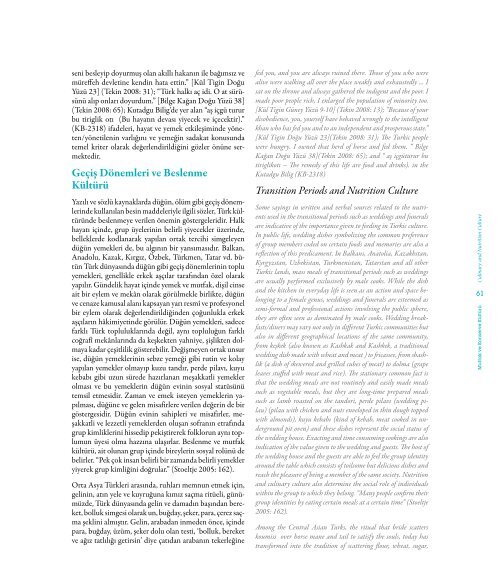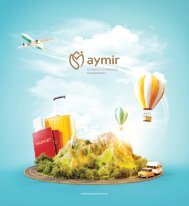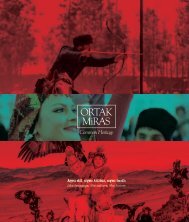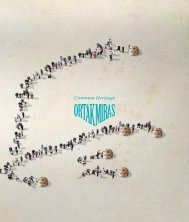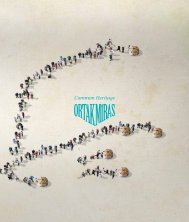You also want an ePaper? Increase the reach of your titles
YUMPU automatically turns print PDFs into web optimized ePapers that Google loves.
seni besleyip doyurmuş olan akıllı hakanın ile bağımsız ve<br />
müreffeh devletine kendin hata ettin.” [Kül Tigin Doğu<br />
Yüzü 23] (Tekin 2008: 31); “Türk halkı aç idi. O at sürüsünü<br />
alıp onları doyurdum.” [Bilge Kağan Doğu Yüzü 38]<br />
(Tekin 2008: 65); Kutadgu Bilig’de yer alan “aş içgü turur<br />
bu tiriglik otı (Bu hayatın devası yiyecek ve içecektir).”<br />
(KB-2318) ifadeleri, hayat ve yemek etkileşiminde yöneten/yönetilenin<br />
varlığını ve yemeğin sadakat konusunda<br />
temel kriter olarak değerlendirildiğini gözler önüne sermektedir.<br />
Geçiş Dönemleri ve Beslenme<br />
Kültürü<br />
Yazılı ve sözlü kaynaklarda düğün, ölüm gibi geçiş dönemlerinde<br />
kullanılan besin maddeleriyle ilgili sözler, Türk kültüründe<br />
beslenmeye verilen önemin göstergeleridir. Halk<br />
hayatı içinde, grup üyelerinin belirli yiyecekler üzerinde,<br />
belleklerde kodlanarak yapılan <strong>ortak</strong> tercihi simgeleyen<br />
düğün yemekleri de, bu algının bir yansımasıdır. Balkan,<br />
Anadolu, Kazak, Kırgız, Özbek, Türkmen, Tatar vd. bütün<br />
Türk dünyasında düğün gibi geçiş dönemlerinin toplu<br />
yemekleri, genellikle erkek aşçılar tarafından özel olarak<br />
yapılır. Gündelik hayat içinde yemek ve mutfak, dişil cinse<br />
ait bir eylem ve mekân olarak görülmekle birlikte, düğün<br />
ve cenaze kamusal alanı kapsayan yarı resmî ve profesyonel<br />
bir eylem olarak değerlendirildiğinden çoğunlukla erkek<br />
aşçıların hâkimiyetinde görülür. Düğün yemekleri, sadece<br />
farklı Türk topluluklarında değil, aynı topluluğun farklı<br />
coğrafî mekânlarında da keşkekten yahniye, şişlikten dolmaya<br />
kadar çeşitlilik gösterebilir. Değişmeyen <strong>ortak</strong> unsur<br />
ise, düğün yemeklerinin sebze yemeği gibi rutin ve kolay<br />
yapılan yemekler olmayıp kuzu tandır, perde pilavı, kuyu<br />
kebabı gibi uzun sürede hazırlanan meşakkatli yemekler<br />
olması ve bu yemeklerin düğün evinin sosyal statüsünü<br />
temsil etmesidir. Zaman ve emek isteyen yemeklerin yapılması,<br />
düğüne ve gelen misafirlere verilen değerin de bir<br />
göstergesidir. Düğün evinin sahipleri ve misafirler, meşakkatli<br />
ve lezzetli yemeklerden oluşan sofranın etrafında<br />
grup kimliklerini hissedip pekiştirerek folklorun aynı toplumun<br />
üyesi olma hazzına ulaşırlar. Beslenme ve mutfak<br />
kültürü, ait olunan grup içinde bireylerin sosyal rolünü de<br />
belirler. “Pek çok insan belirli bir zamanda belirli yemekler<br />
yiyerek grup kimliğini doğrular.” (Stoeltje 2005: 162).<br />
Orta Asya Türkleri arasında, ruhları memnun etmek için,<br />
gelinin, atın yele ve kuyruğuna kımız saçma ritüeli, günümüzde,<br />
Türk dünyasında gelin ve damadın başından bereket,<br />
bolluk simgesi olarak un, buğday, şeker, para, çerez saçma<br />
şeklini almıştır. Gelin, arabadan inmeden önce, içinde<br />
para, buğday, üzüm, şeker dolu olan testi, ‘bolluk, bereket<br />
ve ağız tatlılığı getirsin’ diye çatıdan arabanın tekerleğine<br />
fed you, and you are always ruined there. Those of you who were<br />
alive were walking all over the place weakly and exhaustedly ... I<br />
sat on the throne and always gathered the indigent and the poor. I<br />
made poor people rich, I enlarged the population of minority too.<br />
[Kül Tigin Güney Yüzü 9-10] (Tekin 2008: 13); “Because of your<br />
disobedience, you, yourself have behaved wrongly to the intelligent<br />
khan who has fed you and to an independent and prosperous state.”<br />
[Kül Tigin Doğu Yüzü 23](Tekin 2008: 31); The Turkic people<br />
were hungry. I owned that herd of horse and fed them. “ Bilge<br />
Kağan Doğu Yüzü 38](Tekin 2008: 65); and “ aş içgüturur bu<br />
tiriglikotı – The remedy of this life are food and drinks). in the<br />
Kutadgu Bilig (KB-2318)<br />
Transition Periods and Nutrition Culture<br />
Some sayings in written and verbal sources related to the nutrients<br />
used in the transitional periods such as weddings and funerals<br />
are indicative of the importance given to feeding in Turkic culture.<br />
In public life, wedding dishes symbolizing the common preference<br />
of group members coded on certain foods and memories are also a<br />
reflection of this predicament. In Balkans, Anatolia, Kazakhstan,<br />
Kyrgyzstan, Uzbekistan, Turkmenistan, Tatarstan and all other<br />
Turkic lands, mass meals of transitional periods such as weddings<br />
are usually performed exclusively by male cooks. While the dish<br />
and the kitchen in everyday life is seen as an action and space belonging<br />
to a female genus, weddings and funerals are esteemed as<br />
semi-formal and professional actions involving the public sphere,<br />
they are often seen as dominated by male cooks. Wedding breakfasts/diners<br />
may vary not only in different Turkic communities but<br />
also in different geographical locations of the same community,<br />
from keşkek (also known as Kashkak and Kashkek, a traditional<br />
wedding dish made with wheat and meat ) to fricassee, from shashlik<br />
(a dish of skewered and grilled cubes of meat) to dolma (grape<br />
leaves stuffed with meat and rice). The stationary common fact is<br />
that the wedding meals are not routinely and easily made meals<br />
such as vegetable meals, but they are long-time prepared meals<br />
such as lamb roasted on the tandori, perde pilavı (wedding pilau)<br />
(pilau with chicken and nuts enveloped in thin dough topped<br />
with almonds), kuyu kebabı (kind of kebab, meat cooked in underground<br />
pit oven) and these dishes represent the social status of<br />
the wedding house. Exacting and time consuming cookings are also<br />
indication of the value given to the wedding and guests. The host of<br />
the wedding house and the guests are able to feel the group identity<br />
around the table which consists of toilsome but delicious dishes and<br />
reach the pleasure of being a member of the same society. Nutrition<br />
and culinary culture also determine the social role of individuals<br />
within the group to which they belong. “Many people confirm their<br />
group identities by eating certain meals at a certain time” (Stoeltje<br />
2005: 162).<br />
Among the Central Asian Turks, the ritual that bride scatters<br />
koumiss over horse mane and tail to satisfy the souls, today has<br />
transformed into the tradition of scattering flour, wheat, sugar,<br />
Culinary and Nutrition Culture<br />
61<br />
Mutfak ve Konserve Kültürü


